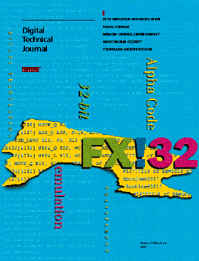
Jane C. Blake,
Managing Editor
No matter how powerful the underlying hardware, most
important to users is how that power translates to
greater application performance and availability. Among
the diverse topics in this issue of the Journal are
innovative ways engineers have devised to meet
application performance and availability requirements,
and new tools for applications developers.
DIGITAL FX!32 is a unique softwareproduct that makes
available hundreds of applications written for Intel
machines to users of Alpha machines. Described by Ray
Hookway and Mark Herdeg, FX!32 combines software
emulation and advanced binary translation techniques to
enable 32-bit applications that run on Intel-based
machines with Windows NTto also run on 64-bit RISC
Alpha-based machines with Windows NT. The design provides
both the performance benefits and the transparency of
operation that the project engineering team sought for
users.
Also designed for the Windows environment is DIGITAL
Visual Fortran, a tool for Fortran developers that
combines technologies from DIGITAL and Microsoft
Corporation. Leo Treggiari reviews the tool’s
components, which include the Component Object Model
(COM), Fortran 90, and Microsoft Developer Studio. He
addresses the question of why developers need help
accessing dynamic link libraries and servers based on
COM, and then focuses on the newly created tool that
provides this functionality, the Fortran Module Wizard.
DIGITAL’s shared-memory cluster interconnect,
MEMORY CHANNEL 2, delivers the high levels of
computational performance necessary to support the
largest technical and commercial applications. Marco
Fillo and Rick Gillett assess experiences with the first
implementation of MEMORY CHANNEL that led to such
enhancements as the crossbar design in this latest
implementation. They conclude with performance data that
demonstrate unparalleled performance in terms of latency
and bandwidth compared with traditional interconnects.
MEMORY CHANNEL 2 provides latency of less than 2.2
microseconds and bandwidth of 1,000 megabytes per second
in an 8-node cluster.
Data security has long been important to system
managers but not easily achieved in distributed
heterogeneous systems. DIGITAL and BEA Systems have
integrated ObjectBroker middleware with the Distributed
Computing Environment’s Generic Security Service
Application Programming Interface (GSS-API), as described
here by John Parodi and Fred Burgher. The authors examine
the choice of GSS-API for ObjectBroker and future
directions in authentication software.
Design decisions made in the development of
DIGITAL’s StrongARM microprocessor were driven by
the sometimes opposing requirements of high performance
and low power consumption. Targeted for use in handheld
appliances usually powered by conventional batteries,
StrongARM offers significantly higher performance than
comparable microprocessors: It operates at 160 MHz,
dissipating less than 450 milliwatts. James Montanaro,
Rich Witek et al. step through the decisions designers
made to implement the ARM V4 instruction set from
Advanced RISC Machines Ltd.
Upcoming in the next issue of the Journal are
technical papers about new AltaVista software and a new
Windows NT personal workstation based on an Alpha 64-bit
RISC processor. To view the results of a recent survey
sent to Journal Web subscribers, see http://www.digital.com/info/dtj/dtj_surv.htm
|